- Region
- Vega baja
- Marina Alta
- Marina Baixa
- Alicante
- Baix Vinalopo
- Alto & Mitja Vinalopo
-
ALL TOWNS
- ALICANTE TOWNS
- Albatera
- Alfaz Del Pi
- Alicante City
- Alcoy
- Almoradi
- Benitatxell
- Bigastro
- Benferri
- Benidorm
- Calosa de Segura
- Calpe
- Catral
- Costa Blanca
- Cox
- Daya Vieja
- Denia
- Elche
- Elda
- Granja de Rocamora
- Guardamar del Segura
- Jacarilla
- Los Montesinos
- Orihuela
- Pedreguer
- Pilar de Horadada
- Playa Flamenca
- Quesada
- Rafal
- Redovan
- Rojales
- San Isidro
- Torrevieja
- Comunidad Valenciana
Monasterio y Iglesia de las Agustinas de Murcia
Churches of Murcia capital, Monasterio y Iglesia de las Agustinas de Murcia
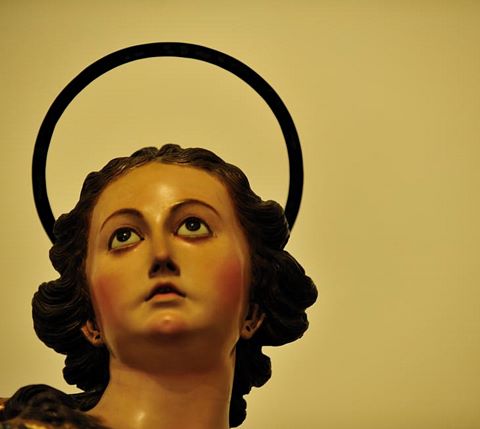 This is a beautiful little church inside the convent and is only open during mass. It has 1 sculpture attributed to Salzillo and a second which came from his workshop and is attributed to his pupil, Roque López.
This is a beautiful little church inside the convent and is only open during mass. It has 1 sculpture attributed to Salzillo and a second which came from his workshop and is attributed to his pupil, Roque López.
It´s just around the corner from the Salzillo Museum (click Salzillo museum)and opposite the Museo de la Ciudad ( click Museo de la Ciudad).
A little history
 On the 14th March 1615 the founders of the Convent of Las Agustinas arrived in the city, and in 1616 the first of what would be three different convents was inaugurated, at this point just a very small church.
On the 14th March 1615 the founders of the Convent of Las Agustinas arrived in the city, and in 1616 the first of what would be three different convents was inaugurated, at this point just a very small church.
The construction was very basic and it soon became apparent that due to the heavy flows of water to which Murcias was vulnerable at this point, that a more substantial and better built building was required, a task undertaken by Bishop don Francisco de Rojas y Borja, whose escudos ( coat of arms carved in stone) are still to be seen in the current building on the western fachada.
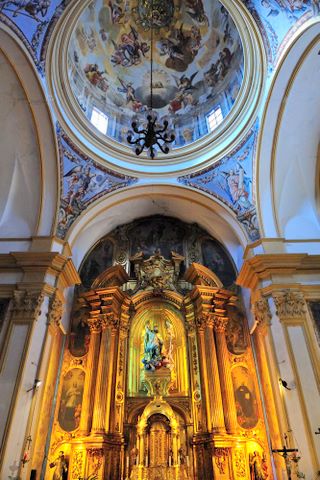 What we see today is the third version, built to accommodate the increased number of those seeking the veil, the amplio y hermoso templo the ample and beautiful temple requested by the Bishop.
What we see today is the third version, built to accommodate the increased number of those seeking the veil, the amplio y hermoso templo the ample and beautiful temple requested by the Bishop.
However, the Mother Superior, Madre Juana de la Encarnación (la Santa Teresa Murciana) the murcian Santa Teresa expressed her fear to the Bishop, now Bishop D. José Tomás de Montes, that the work when completed was out of tune with the spirit of religious austerity and poverty which had always characterised the convent in the past in favour of the "sumptuousness" with which the building and cloisters were being decorated. To which the "Prince of the church" as he was known at that point replied, "Leave your shepherd to work following the impulses of his heart....." a comment for which the earnest Mother superior could only answer by praying for a little more humility of spirit.
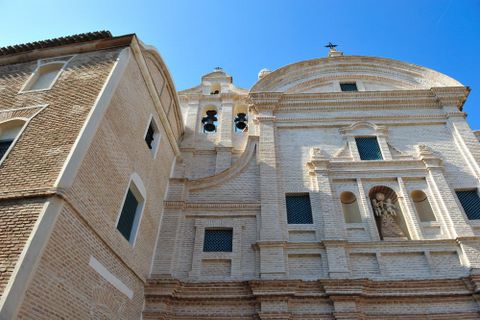 On the 22nd November 1783, Roque López, fellow craftsman who worked in the workshop of the master sculptor Francisco Salzillo, Click Francisco Salzillo, delivered the image of Santa Cecilia, which is now back in the chapel.
On the 22nd November 1783, Roque López, fellow craftsman who worked in the workshop of the master sculptor Francisco Salzillo, Click Francisco Salzillo, delivered the image of Santa Cecilia, which is now back in the chapel.
The great disaster for the convent came in 1936 when the Civil war forced the nuns to abandon the convent, unable to save many of the treasures and archives it held, losing all the retablos ( the major altar pieces) except the main one, the tabernacle and the altar table which was reconstructed just a few years ago. Thanks to an old photograph restorers were able to reconstruct the tabernacle exactly as per the original, except that the images of faith , hope and charity by the master sculptor Salzillo which had been lost were replaced with newer versions by D. José Díaz Carrión. Tragically, the images of the Dolorosa, Santa Teresa de Jesús, Santa Rita de Caria and San Nicolás de Tolentino were all destroyed.
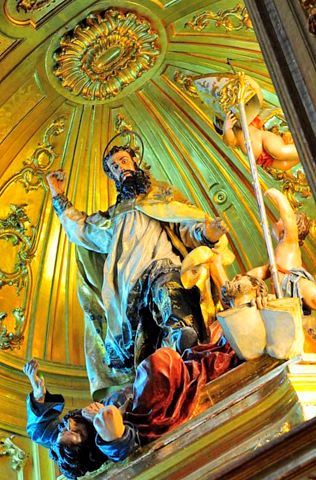 In the years subsequent to 1936 the church and convent were converted into a jail and military billet, suffering considerable damage which was aggravated when the buildings were turned into a refuge for families who had lost their homes due to the serious flooding which inundated the city at this period.
In the years subsequent to 1936 the church and convent were converted into a jail and military billet, suffering considerable damage which was aggravated when the buildings were turned into a refuge for families who had lost their homes due to the serious flooding which inundated the city at this period.
By the 1950´s efforts were underway to reconstruct the whole area surrounding the monastery, and somewhat unorthodox works were undertaken in the Calle de San Andrés where great holes were knocked into the ground floor, rented out by the community as workshops and stores and even a gymnasium for the Youth Front.
It has now undergone complete restoration which although unable to return it to its former glory, creates nonthless a beautiful church with a harmonious air and some special artworks.
 Architecture
Architecture
The fachada of the building is very representative of the type of architecture employed in the first part of the 18th century, particularly interesting because it uses a number of brick pillars and columns to subdivide the elements of the fachada.
Principal works.
San Agustin
The retablo ( main alter piece) is by D. José Ganga Ripoll, the main central statue believed to be by Francisco Salzillo, made between 1755-1760. It represents San Agustin, his right hand raised in the air believed to have been clutching the feather of learning before the Civil war, whilst he tramples heretics beneath his feet, representing the fight of learning and the Catholic Church over paganism and heresy.
His left arm has been replaced during restoration and it is believed could have been holding a book
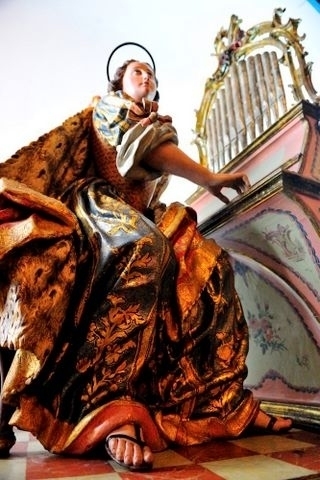 Santa Cecilia (1783)
Santa Cecilia (1783)
This piece was delivered to the church by Roque López in the year during which Francisco Salzillo died. Although popular legend attributes it to Salzillo, those who have studied the subject in great detail say that it is made entirely by Roque López.
Unlisted but very beautiful
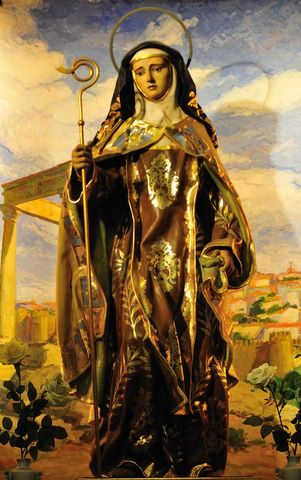 Another particularly striking piece is not listed anywhere on the official information about the church but stood out for us when we visited for its purity and simple beauty. We will get back to the church and confirm the sculptor and date, but don´t miss it if you visit as it´s a very beautiful piece.
Another particularly striking piece is not listed anywhere on the official information about the church but stood out for us when we visited for its purity and simple beauty. We will get back to the church and confirm the sculptor and date, but don´t miss it if you visit as it´s a very beautiful piece.
Visiting the Monastery.
 The Monastery and church are not open to general public at any time other than during mass, so if you want to go in, you have to do it then.
The Monastery and church are not open to general public at any time other than during mass, so if you want to go in, you have to do it then.
Mass takes place as follows;
Weekdays and festivals, 7pm
Sundays and festival days 9.30am, mass and Vispers is sung at 6.20pm
The monastery is a 2 minute walk from the Salzillo Museum, so if you were planning to go and visit the museum, you could arrange to go to mass in this church first. saint Cecilia is right at the back, and San Agustin is in the main alterpiece.
It´s also virtually opposite the museo de la ciudad, where you can see more information about the floods which devastated Murcia which we mention above.
Click for map, Plaza san Agustin, Murcia






































